|
The Upside-Down World of Occupied Japan
| by Kathy Gardner
Posted October 2013
|
 |
What is Occupied Japan anyway? Those of us who are older have long learned about its history and then become fascinated, amazed and addicted to the array of items that bear the mark of “Occupied Japan” (OJ).
OJ has a history and a language of its own, and we learn it with great pleasure. The first thing a collector reads is that the Occupied Japan marks appeared on virtually everything exported from Japan between Sept.1945 and April 1952. Research realizes, however, that the marks weren't mandated until Feb.1947 by the Supreme Commander for the Allied Powers who issued a memorandum to the Imperial Japanese Government ordering the use of the words Made in Occupied Japan or Occupied Japan. The author Lawrence Wonsch says the memorandum was "rescinded and made optional" in Dec.1949, but manufacturers continued the marks until 1952 for various reasons.
|
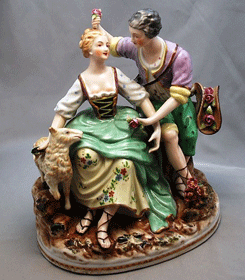
|
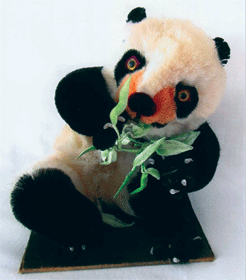
|
|
An Occupied Japan porcelain couple figurine
by manufacturer Maruyama China.
|
This bottle brush Panda bear is seven inches tall
and is made of bottle brushes, $40-$45.
|
I reach back to an article by Occupied Japan expert Florence Archambault for these thoughts: “Research in the National Archives has uncovered further information. Until Japan was opened for foreign trade in Aug. of 1947, all trade was handled by the United State Commercial Company (USCC). This contract was in effect from Jan. 17, 1946 until Dec. 31, 1947 for all exportation from Japan into the U.S., except for textiles produced from Commodity Credit Corporation (another vehicle set up for the exportation of the textiles). The only manufactured items brought into the U.S. during 1946 were Christmas tree lamps and sockets and several cases of samples of handicraft products that were exhibited to the trade showroom located in New York City. This means that any of the figurines and other manufactured pieces did not come into the country before 1947.”
In the upside-down world of OJ collecting where one is always turning a piece upside down to look for the mark, it has been said that the experienced collector can smell an OJ mark without turning a piece over. For the beginner, that is the thrill of the hunt, especially upon finding an item outside the expected figurine, teacup or salt shaker. One begins to examine everything looking for that magic mark.
|
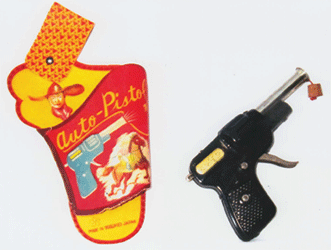
|
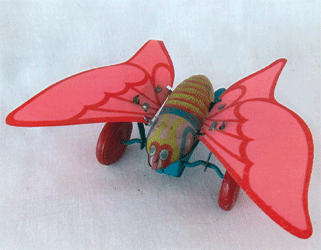
|
|
Occupied Japan includes a multitude of toys
like this cork pistol popgun.
|
A wind-up butterfly with celluloid wings.
|
There are hundreds of porcelain and bisque pieces available, from dime-store quality that the housewife could easily afford for her dinner table or for adding a spot of decoration to her home to the tall and gorgeous that appealed to the more affluent taste. Then add to that the multitude of categories of linens, such as the boxed tablecloth and napkins probably given to a new bride who never used them. There are baskets, paper goods and books. Jewelry may be stringed beads to fancy boxed sets. Gloves, scarves and hats still have the tags attached. There are cameras, fishing poles and lures, tennis rackets, tools and many toys. There are oddities like a box of bisque dice, a bottle-cleaning brush koala bear and a chiropractic electric massage. In that group are porcelain insulators that only went to Australia. These are just some of the numerous unexpected finds that appeal to the novelty collector.
High on the desirability list in the last ten years is a group of 45 Hummel look-alikes called American Children, each with its own title name and OJ mark. Desirability is looked at in the complexity of a figure, if it has delicate flowers and intact fingers, for instance. Horse-drawn coaches, for an example, are judged by the number of horses on the piece. Bisque versus porcelain sometimes guides the likability.
|
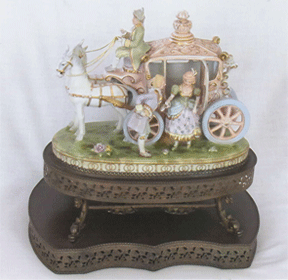
|

|
|
A two-horse coach, valued at $200-$275.
|
Little Astrologer, one in a series of Hummel-like figurines known as American Children, $50-$75
|
Most collectors begin by purchasing everything they see and find, but then the taste develops, and it is discovered that "big and beautiful" is better. Certainly, that is not an absolute. No matter what stage of the search, it is imperative to determine and make sure that a mark does not come off and is under a glaze or otherwise permanent.
Like other collectables, there are fakes. Many misconceptions are portrayed and related about authenticity. The mark is everything to the Occupied Japan collector since it is the qualifier. Nothing else will do!
Besides recognizing these issues, it is important (to any collector) to know values. Asking prices can be from reasonable to ridiculous. Although the available reference books are aging now, the values have fallen back into line with today's market prices, and those books still provide a good visual tool to learn the items that received the OJ mark in order to gain search experience.
Help on the subject can always be found by contacting the 35-year-old OJ Club (www.facebook.com/theoccupiedjapancollectors) with its many veteran collectors and its two new leaders, Shoko Tanaka (1312 Marina Circle, Marina, CA. 95616 or shoko1122@gmail.com) and Kathy Gardner (220 East Washington St., Bluffton, IN 46714 or klgardner45@yahoo.com). Shoko has lived in the U.S. for 30 years and is an amazing twist to the future of the club. She has given lectures on OJ at Japanese galleries and universities and held her own exhibitions. Kathy Gardner is a 27-year collector. A new vision and focus of the club are to introduce OJ back to the Japanese people, who, like us in the U.S., have forgotten or never known this piece of history. The two have teamed up as an unlikely duo brought together by chance to take the Upside Down World of the OJ collector to new perspectives.
Occupied Japan Unknown to Most Japanese Something Old Is Something New to Most Japanese
by Shoko Tanaka
Most Occupied Japan items were produced for the overseas market when the Japanese economy was war-torn and people in general had a difficult time feeding themselves. Occupied Japan items were manufactured and exported to earn foreign currencies while the Japanese economy was being reconstructed into a normal demilitarized economy.
The main export market of Occupied Japan items was North America. This is especially true with ceramic and porcelain goods, which were designed and produced to satisfy the consumers in the U.S. and Canada.
|
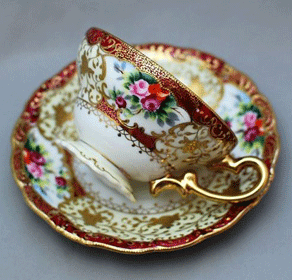
|
A cup and saucer set by Chubu China.
|
It is interesting to note that the majority of Japanese have never seen Occupied Japan items and have few clues about what they are. Only some stocked items have been found and traded in flea markets and antique stores. In fact, the Japanese perception of "Occupied Japan items" is traditional Japanese-style souvenirs that military personnel brought home. They are surprised to see real OJ items.
Many of the porcelain and ceramic goods OJ enthusiasts have shown interest in were produced in Seto and Nagoya in Japan. Those cities have a few-hundred-year history of porcelain, bisque and ceramic production, having exporting them overseas since the late 1800s. The trade was very active in the 1920s and ‘30s, but it was cut off by the war.
It is interesting that we can find a similarity between products made pre-war and during the Occupation period. This may be because some OJ items had already been produced and stored away before the war and then later stamped "Occupied Japan" for export, or the molds were re-used to make OJs.
The city of Seto, located north of Nagoya, was the main production site of figurines, dolls and salt and pepper shakers. Maruyama China was a major producer of high-quality figurines, and 2014 will be their 100-year anniversary, even though the company stopped production years ago.
Nagoya was a center for many makers of porcelain products, such as dinner sets, cups and saucers, and decorative items because it had a long tradition of ceramic painting. Noritake is one of the major producers in Nagoya of dinner sets and other decorative goods. Other makers such as Meito, Shofu China, Tashiro Shoten, S.G. K. and Chubu China also put out beautiful sets of dishes, cups and saucers, and vases.
Occupied Japan items are peace-time products which Japanese should be proud of. It is wonderful that there are collectors like us in the U.S. and Canada who cherish them and share the joy of collecting and share knowledge. We hope the tradition of collecting will continue.
----------------------------------
Kathy Gardener has collected Occupied Japan for 27 years, and she also has a high interest in all things antique coming from Dunkirk, Indiana, the home of Indiana Glass. She owns and operates the Washington Street Inn in Bluffton, Indiana.
|